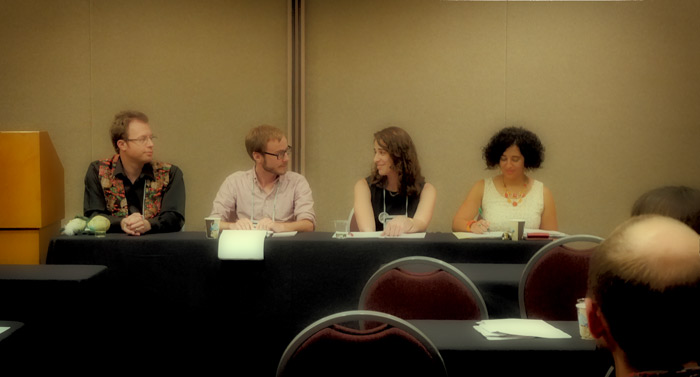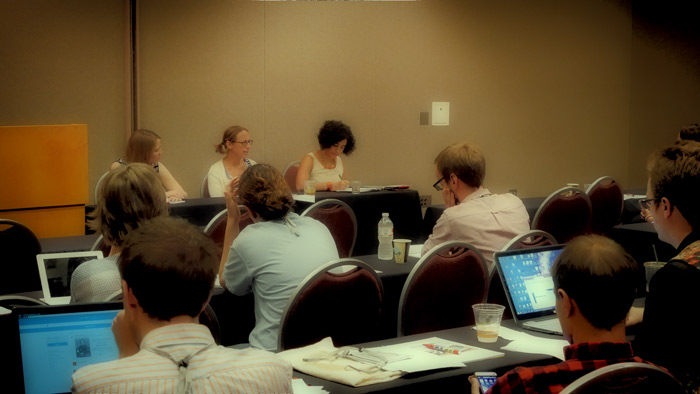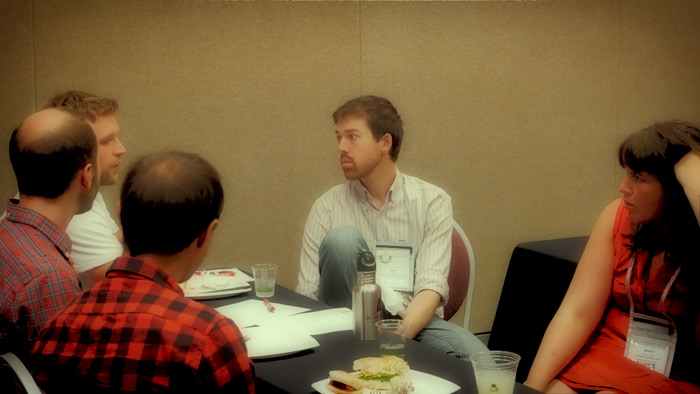Communicating Plant Biology

This is a guest post from Eric Hamilton
After four long days at a conference, all you want to do is board a flight home, crawl into bed, and try to forget how your boss saw you dancing at the open-bar party. But on July 30, 2015, a dedicated group of scientists and communicators rallied at the end of Plant Biology 2015 conference in Minneapolis, MN, for the Standing Up for Science Media Workshop on science and the public engagement hosted by Sense About Science USA.
As the 2015 ASPB-sponsored AAAS Mass Media Fellow, I was invited to participate in the workshop and talk about why and how I began pursuing opportunities in science communication. And I eagerly joined my colleagues in discussing ways early-career scientists can improve how science weaves its way into the media.
The media workshop was divided into three sessions, with a corresponding panel of scientists, journalists, and scientist-communicators.
To start, Douglas Cook, a professor at University of California, Davis, made it clear that scientists should be firm about combatting myths and speaking forcefully for evidence-based action. “Science is not democracy,” he said, no matter what the polls say. For effective communication, facts and data are insufficient—people find their own version of the truth. Instead, Cook suggested, look for the values people hold, and see if your work can fulfill those values.
Coming at the issue of how to engage with the public from a different perspective, Sally Mackenzie, a professor at the University of Nebraska-Lincoln and president-elect of ASPB, felt that a coordinated, repeated message could break through even to opponents of some scientific advance, such as genetically modified (GM) foods. “Some level of activism is our responsibility,” she said, dispensing with the notion that scientists should remain disinterested observers from their labs.
During the question and discussion period of the session, we discussed the labor force of science communication: should it be advanced by scientists who add on communication, or by dedicated communicators with scientific training? Do you need a Ph.D., or is a Bachelor’s degree sufficient? Do you need to study science at all?
The issue we kept coming back to is whose responsibility is communicating science? In academia, science communication is usually left as an extracurricular activity for overworked professors. That will never compete with efforts made by organizations that are committed to advocacy that goes against science and evidence. For instance, as someone noted Greenpeace—a vocal opponent of GM foods—spends $185 million a year on communication alone [The figure was closer to $211 million in 2013].
And with that, it was time for lunch and group work on what the media gets right and wrong when covering science, which led to the second session for the day. In the journalist panel we heard from Emily Sohn, a freelancer and contributor to the Science Writer’s Handbook, and Elizabeth Dunbar of Minnesota Public Radio.

Journalists Elizabeth Dunbar and Emily Sohn (left to right) tell the audience how they work and how scientists can better engage with the media to ensure that science is correctly communicated.
To a room filled mostly with scientists, Sohn described how she finds stories, and how scientists can help her get their research to the public. If you are responsive to emails and phone calls from journalists and give clear, concise answers to questions, you might just end up as one of her “Super Sources” – someone she returns to time and again. And though Cook and Mackenzie, as well as several other scientists in the audience, felt that they had “been burned” by sloppy journalism, Sohn tried to make clear that she was on their team: “We’re all trying to get it right,” she said.
Dunbar, who had stumbled into science journalism from a general assignment background, freely admitted that in radio—where four minutes is a lifetime—she has learned that to communicate effectively she needs to cut all but the most basic scientific concepts. “I try to teach my audience something about science,” she said, and then explain just a fraction of the hot new research.
At the end of the panel discussion, the audience was given a chance to pitch their own work to the journalists to see how well they could capture attention for a possible story. In one instance, Sohn and Dunbar helped Don Gibson, a Ph.D. student at the University of California, Davis, to plan his pitch to journalists on his campaign to put Barbara McClintock on the ten-dollar bill. Their advice: Give a positive message, and make the main point—it’s time to put a female scientist on currency—pop out right away.

The final panel of the day discuss different resources and opportunities for science students to get involved in science communication. From left to right: Karl Haro von Mogel, Eric Hamilton, Natalie Henkhaus, and Neda Afsarmanesh.
And then it was finally time for the last panel, where, I joined Karl Haro von Mogel of Biology Fortified; Natalie Henkaus of the Boyce Thompson Institute (which supported the workshop) and soon-to-be ASPB staff member; and Neda Afsarmanesh, Deputy Directory of SAS USA and the organizer of the Media Workshop. We all had scientific backgrounds and we were all in the process of or had already moved into full-time science communication positions.
Henkaus stressed the importance of collaborative communication efforts from the NSF’s Research Coordination Networks, ASPB’s National Plant Science Council, and Cornell’s Alliance for Science (another supporter of the day’s workshop). Von Hogel described how Biology Fortified began as a group blog and morphed into a forceful advocate for biotechnology—and purveyor of cute GMOs. And I got to tell what it’s like to jump straight from the lab into the newsroom, and the importance of funding for training in communication. As the final panel, we had the luxury of longer, casual conversations that conveniently morphed into hor d’oeuvres and drinks. Business cards were exchanged; dramatic reenactments of speeches were staged; theories of science communication were pored over and debated.
My takeaway from the day: Journalists and scientists have a lot in common. They both want to tell others about what they see in the world—what they know to be true—and they both want everyone to be as excited about the story they have to tell as they are.
Eric Hamilton is a Ph.D. candidate in Plant Biology at Washington University in St. Louis, where his research in the lab of Elizabeth Haswell focuses on mechanosensation and pollen’s response to stress. He has given a number of presentations in the St. Louis area on plant science, genetic engineering, and crop domestication, working closely with the community gardening organization Gateway Greening, and is an advocate for improving the communication of science to diverse audiences. Eric currently works as the ASPB-sponsored AAAS Mass Media Fellow at the Milwaukee Journal Sentinel, covering science for the regional newspaper during this 10-week program. You can find his work at hamiltonerics.com and follow him on Twitter, @hamiltonerics.


Trackbacks/Pingbacks